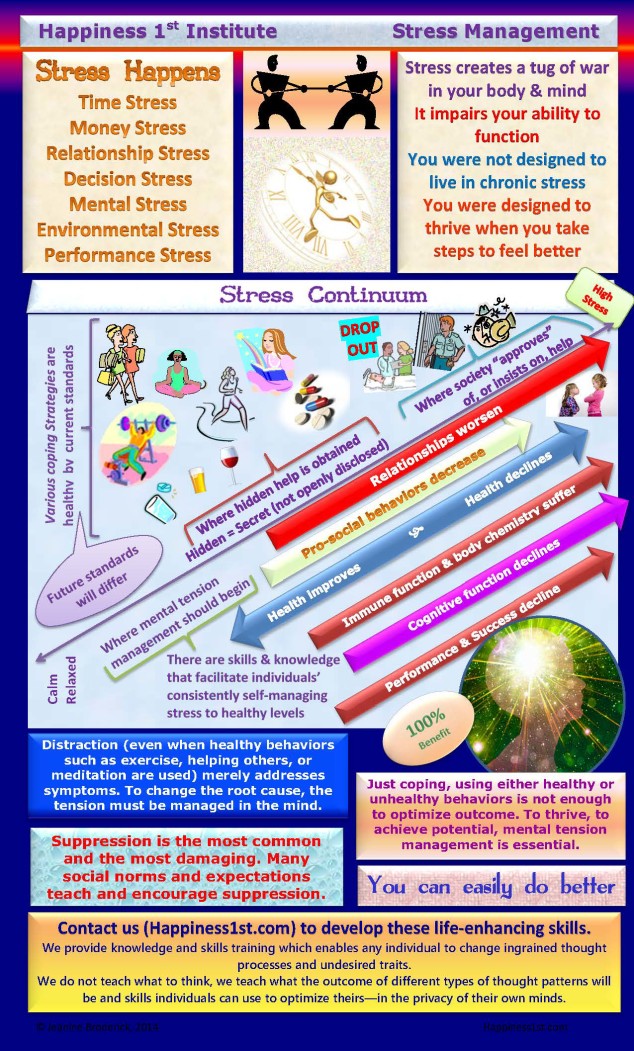What Do Lack of Employee Engagement, Altruism, Volunteerism have in Common?
They are all symptoms of the same root cause.
Our behavior is closely connected to our emotional state. Almost every beneficial behavior increases when an individual feels good emotionally and worsens when the individual feels less than positive emotions.
Our chronic emotional state, which is our dominant emotional state, affects how we perceive the world around us. Below our conscious level of awareness, the inputs from our senses are sorted and only some of the information is passed to our conscious mind. Our senses receive so much information the filtering process is necessary. Much of the information is irrelevant. If you continuously felt every place your clothes touch you skin, it would make it difficult to think about other things.
These filters make a lot of decisions before we are even aware the information is available–deciding what to send to the conscious mind and what not to send. One filter is based on how we feel emotionally. There is more than one filter that uses emotion. Your current mood is the basis of one filter. Have you ever noticed that when you’re angry you suddenly remember other things you were angry about in the past that are like the thing you are currently angry about–things you haven’t thought about in a while.
Another filter is based on your chronic emotional state. Your chronic emotional state is simply the emotional state you’re often in. Some people might even consider it their personality–it isn’t, but it can seem that way because our chronic state is based on habits of thought that most people do not change throughout life. We even have archetypes, such as the Drama Queen that represent a chronic emotional state characterized by frustration, irritation, impatience, being overwhelmed and frequent disappointments.
Because of the filtering process, someone who is frequently frustrated will focus on areas of life that are frustrating while ignoring areas that would be easy to appreciate. Likewise, someone who is frequently angry will focus on things that make her angry–even when there is much to appreciate in her environment. Someone who is frequently in a state of appreciation will focus on things he appreciates and be less aware of things that would make him frustrated or angry.
Engagement
Being engaged at work requires interest in and a desire to do the work with a positive attitude. Someone whose filters are continually highlighting less than positive aspects about their job, their performance, their boss, their co-workers, and the company they work for will find it difficult to be engaged at work. Even when the company makes an effort to make sure they provide a good work environment, the employee’s filters continue to primarily highlight the negative more than the positive.
The recent economic downturn shifted a lot of people who were more fearful than usual during the downturn, to a lower chronic emotional state. At that same time, many companies had to ask employees to do more with less. It is not surprising that Gallup is reporting low employee engagement numbers worldwide. In Gallup’s most recent report only 30% of American workers were engaged, 20% were actively disengaged and 50% were not engaged. The annual cost estimated by Gallup for the actively disengaged workers lack of engagement was 450-550 billion dollars.
Better Managers
Gallup’s recommendation include improving management but even a wonderful manager will not be perceived as wonderful by an employee whose filtering system is highlighting the worse–or interpreting the manager’s words and actions in a negative way.
Praise of an employee’s work is easily received by an individual who is in a state of appreciation. Praise the work of an employee who is chronically frustrated and the employee may misinterpret it to mean you’re getting ready to ask for things that are frustration (buttering up instead of honest praise). The manager cannot control this. The emotionally intelligent manager may be more aware of what is happening and able to get through the filters for some frustrated employees some of the time–but it is the hard way of going about it.
Also, managers have the same sorts of brains with their own filtering system. Many of them were affected by the economic downturn.
It is not just the people who were directly affected whose chronic emotional state slid lower. The level of fear rose in many people who never experienced negative economic impacts from the downturn.
Altruism and Volunteerism
Countries with low employee engagement also report low rates of altruism and volunteerism. Researchers have already linked good corporate citizenship, altruistic behavior, volunteerism, and kindness to strangers to positive mood. Researchers have found that when people feel good, they do good. Being kind can also promote a sense of community, which is known to increase engagement.
When someone does something nice for someone else, more kind behavior is inspired by feelings of gratitude.
There is some evidence linking guilt to positive behavior and some charities attempt to guilt donors into giving but this is not recommended because guilt causes stress that is associated with negative health outcomes. Guilt is more about restoring a perceived imbalance -1 + 1 = 0, a zero sum game. Whereas pure altruism adds value to the world.
Intrinsic Motivation
Intrinsic motivation is one of the reasons employee engagement is so beneficial to employers. Positive mood is associated with greater intrinsic motivation.
The Effect of Resilience
We all know that one person can remain engaged even under the most trying of circumstances while others engagement rapidly declines when stressors are present. Resilience is a critical trait in the workforce. Without resilience employees will not function well when something makes them lose their mental-emotional balance. No one can control what happens to them during their life, marriages fail, loved ones die, people become ill and require care or perseverance to get through difficult treatments, business struggle and sometimes our fears about safety, for ourselves, our family and even our country seem eminent. The ability to bounce back and function in the aftermath of such events is crucial.
Every business continuity plan requires employees to be able to act. If the employees are not resilient, some of them will not meet the challenges. Resilience is a skill that can be built in advance–a skill that increases when positivity is increased.
Employee Wellness
Another area that Gallup links to increased engagement is higher levels of employee wellness. That is no surprise to me because wellness goals are far more likely to be achieved in the positively focused individual.
I’ve already outlined the link between chronic stress, positivity, and wellness program outcomes in The Key Ingredient Your Corporate Wellness Program is Missing and a few other articles (links below) so I won’t elaborate on them here. Increasing positivity improves the root cause of wellness. For a full discussion, see my book TRUE Prevention–Optimum Health: Remember Galileo.
The Root Cause
The root cause of engagement, altruism, volunteerism, intrinsic motivation and resilience can be traced directly to chronic emotional stance. With the right skills and tools, improving chronic emotional state is easy. It is a new approach to engagement and wellness. Prepare for results that exceed expectations.
Twenty years of cross disciplinary research has gone into developing and fine tuning our methods. The early adopters will achieve significant advantages over their slower competitors. There is nothing to lose and much to gain. We offer a free consultation to businesses and for individuals, our premier programs come with a money back guarantee. Call today for a better tomorrow.
***
Jeanine Joy is an author, speaker, and CEO focused on improving human thriving. For techniques on defusing stressful thoughts so you can relax and enjoy life more, try one of my books or programs. Also watch for a book focused on optional aspects of aging and not taking those options. It may be late 2015 or 2016 before that one is out but it will address this issue in more detail.
Please consider sharing this information with your network. If you found it valuable, they may also find value in what I have written.
I wish for you many blissings. (Blissings = blissful blessings)
About : Jeanine Joy Jeanine Joy is an inspiring and life-changing author, speaker, and scholar. The purpose of her life is to seek out knowledge that increases human thriving, create explanations and processes that provide practical ways for individuals adopt strategies that enhance their lives. Her programs, books, and speeches empower people to fulfill their dreams and enjoy more loving, happy, and successful lives. Her ultimate goal is to help create a better world for everyone on Earth.
Available Now


Coming in 2015






